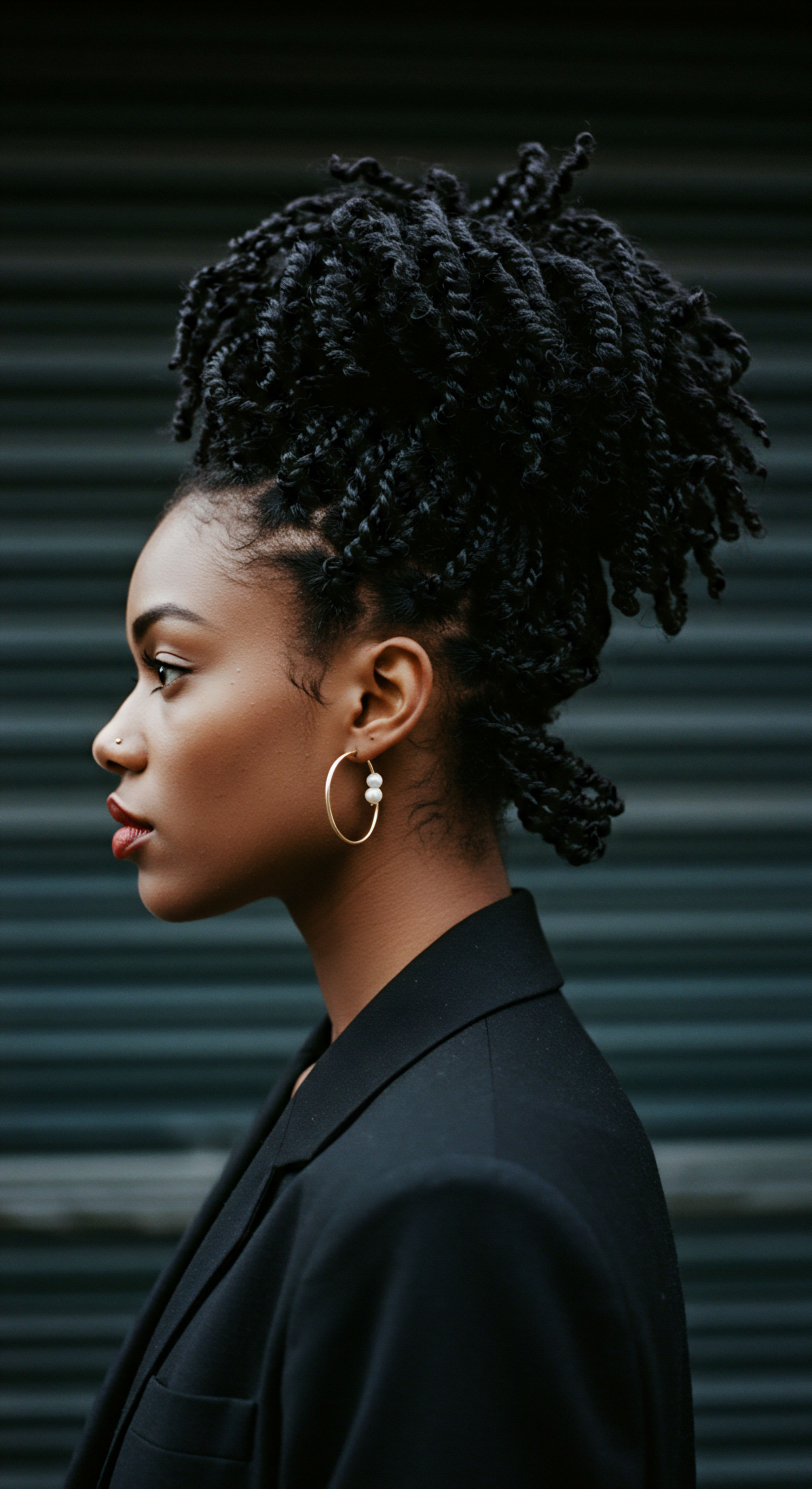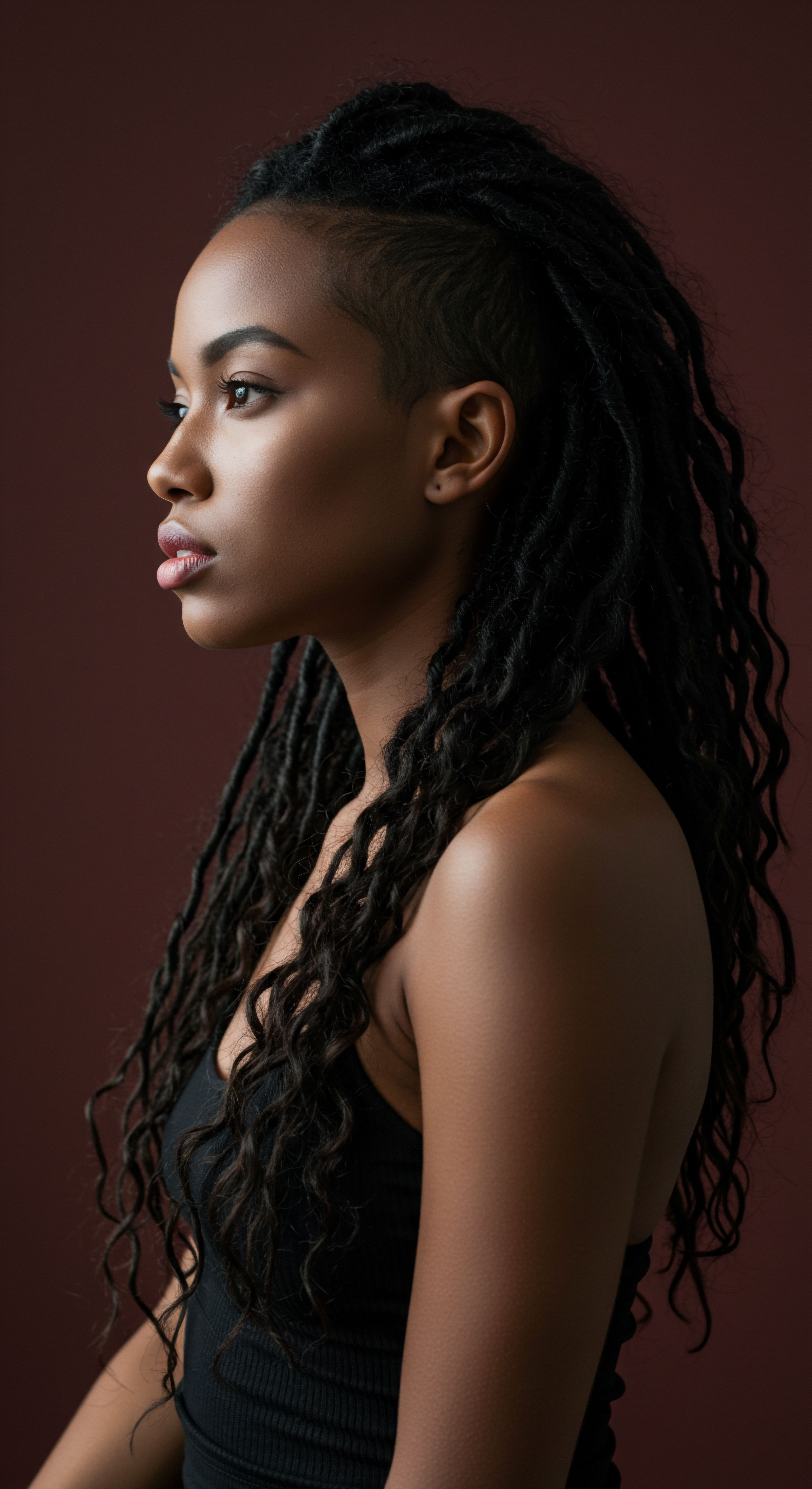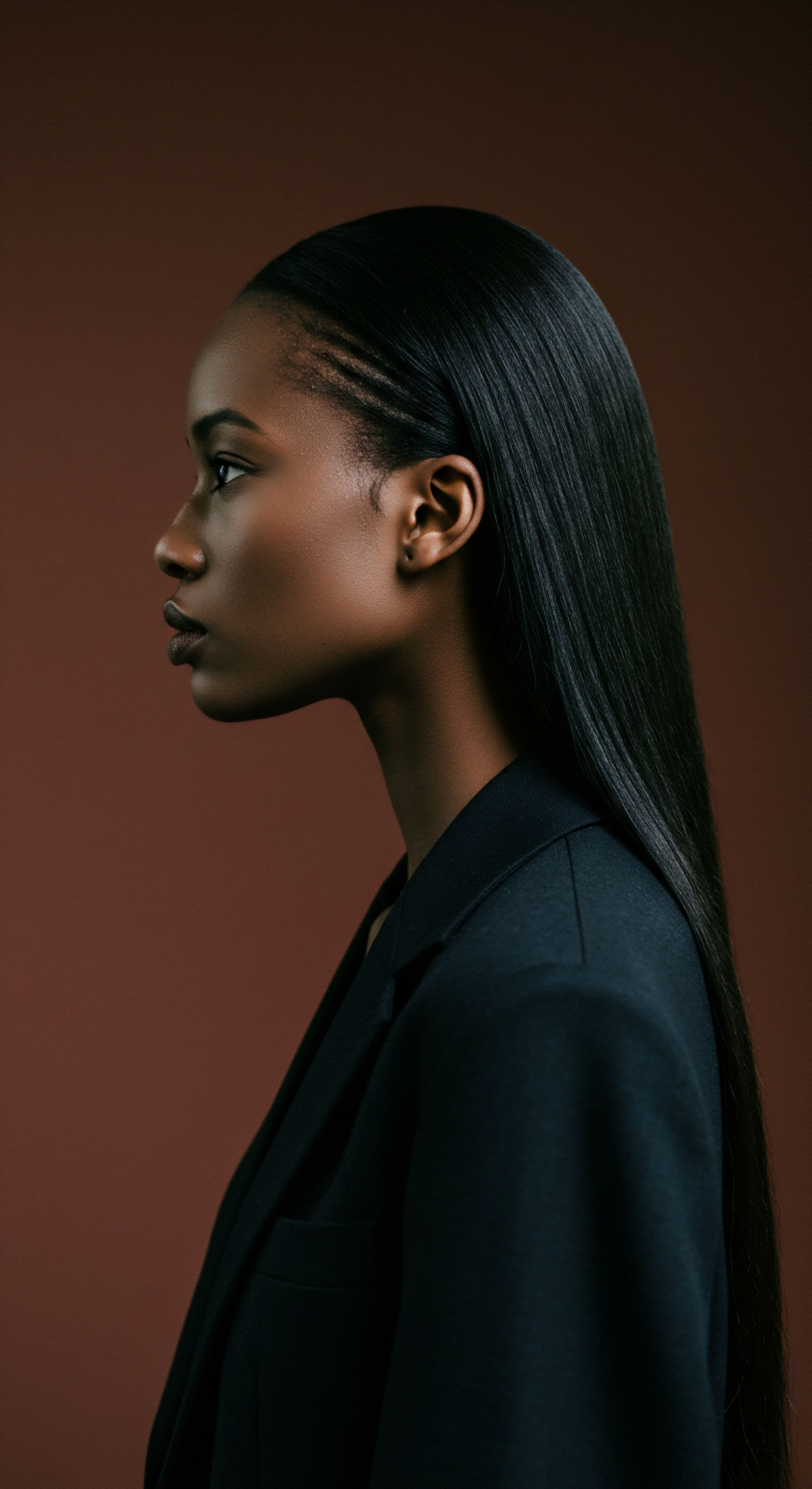
Roots
Our hair, particularly textured strands, carries stories within its coils and kinks, whispers of heritage, and resilience. It is more than just a crown; it is a profound connection to self and lineage. When we speak of hairline health, we are not merely discussing aesthetics; we are delving into the very foundations of well-being, where the body’s inner workings manifest in the delicate dance of growth at our edges.
Understanding what supports this tender area requires a gaze beyond surface solutions, reaching into the nourishing elements we invite into our bodies. It is a quiet conversation between our cells and the world around us, expressed through the vibrancy, or sometimes the vulnerability, of our hair.

The Hairline’s Delicate Design
The hairline, often a site of concern for those with textured hair, represents a unique anatomical zone. Here, hair follicles can be particularly susceptible to external stressors, like tension from styling, and internal signals, such as nutritional shifts. Each strand emerges from a tiny organ beneath the scalp, the hair follicle, which is a bustling hub of cellular activity. These follicles, especially around the edges, are sensitive barometers of our overall health.
They require a steady supply of specific building blocks and supportive compounds to maintain their integrity and continue their growth cycle. When these needs are unmet, the hairline often shows the first signs of distress, perhaps through thinning, fragility, or a reluctance to grow.

Hair Growth Cycles and Their Nutritional Demands
Hair growth proceeds in distinct phases ❉ the active growth phase, known as anagen; a brief transitional phase, catagen; and a resting phase, telogen. For healthy hair, the anagen phase should be robust and prolonged. This requires a constant supply of energy and raw materials.
When nutritional deficiencies arise, the hair follicle may prematurely enter the resting phase, leading to increased shedding and reduced density. This cycle is particularly sensitive to the availability of certain micronutrients.
The hairline, a sensitive indicator of inner balance, reveals its health through the vitality of each strand.
- Anagen ❉ The active growth phase, where hair cells divide rapidly. This phase demands significant energy and protein.
- Catagen ❉ A short, transitional phase where growth ceases and the follicle shrinks.
- Telogen ❉ The resting phase, after which the old hair sheds and a new one begins to grow.
The intricate process of hair formation, particularly the creation of keratin, the primary protein composing hair, depends heavily on dietary protein. Without sufficient protein, the very structure of the hair can be compromised, leading to weaker, more brittle strands. This becomes even more pertinent for textured hair, which by its nature can be more prone to dryness and breakage due to its unique structural properties.

Ritual
Stepping from the fundamental understanding of hair’s inner workings, we arrive at the practical wisdom of nourishing our hair from within. The journey toward a resilient hairline for textured hair involves a conscious practice, a thoughtful integration of specific dietary choices into our daily rhythm. This is not about fleeting trends or restrictive measures, but about a sustained, gentle approach that honors the body’s need for balance. It is about understanding that what we consume acts as a silent ritual, contributing to the strength and vibrancy that radiates from our strands.

What Dietary Adjustments Can Support Hairline Health?
To nurture a healthy hairline, a focus on a diverse array of nutrients becomes paramount. Our bodies are complex ecosystems, and hair, though seemingly external, mirrors the internal landscape. Adequate intake of specific vitamins, minerals, and macronutrients plays a direct role in the structural integrity of hair, the health of the scalp, and the regulation of the hair growth cycle.

Protein Power for Hairline Protection
Hair is primarily protein, specifically keratin. Ensuring sufficient protein intake provides the necessary building blocks for strong hair strands. For textured hair, which can be more susceptible to mechanical stress, robust protein structures are especially beneficial.
Sources of high-quality protein include lean meats, fish, eggs, and a variety of plant-based options. For instance, Chickpeas, Lentils, Tofu, and Nuts provide amino acids vital for keratin synthesis.

The Significance of Micronutrients for Scalp Vitality
Beyond protein, a symphony of micronutrients conducts the health of our hair follicles.
- Iron ❉ A deficiency in iron, particularly iron deficiency anemia, is a common cause of hair loss, including thinning at the hairline. Iron transports oxygen to hair follicles, a process essential for their growth and repair. Pairing iron-rich foods with sources of Vitamin C, such as bell peppers or citrus fruits, can significantly enhance absorption.
- Zinc ❉ This mineral plays a part in tissue growth and repair, including hair. It also helps maintain the oil glands around hair follicles. Oysters, beef, and pumpkin seeds are excellent sources.
- Vitamin D ❉ Research indicates that Vitamin D has a direct action on dermal papilla cells, which are crucial for hair growth. Many individuals, especially those with darker skin tones, may have insufficient Vitamin D levels. Sun exposure is a primary source, but dietary additions like fatty fish or fortified foods can help.
- Omega-3 Fatty Acids ❉ These essential fats possess anti-inflammatory properties and are vital for scalp health and hair hydration. They nourish hair follicles and support circulation to the scalp, which brings nutrients to the hair. Fatty fish like salmon, mackerel, and sardines are rich sources, as are plant-based options such as flaxseeds and chia seeds.
- B Vitamins ❉ The B-complex vitamins, including Biotin (B7) and Niacin (B3), are central to hair health. Biotin supports keratin production, while Niacin improves blood circulation to the scalp. Whole grains, eggs, nuts, and leafy greens contribute to adequate B vitamin intake.
Nourishing textured hair from within demands a conscious, sustained practice of dietary adjustments, moving beyond fleeting trends.
Consider a gentle shift towards incorporating these nutrient-dense foods into your regular meals. This steady provision of essential elements allows the hair follicles to function optimally, supporting the hairline’s resilience against daily challenges.
| Nutrient Protein |
| Role in Hair Health Building blocks of keratin, structural integrity |
| Dietary Sources Lean meats, fish, eggs, lentils, chickpeas, tofu |
| Nutrient Iron |
| Role in Hair Health Oxygen transport to follicles, prevents shedding |
| Dietary Sources Spinach, lentils, red meat, fortified cereals |
| Nutrient Zinc |
| Role in Hair Health Tissue growth, oil gland maintenance |
| Dietary Sources Oysters, pumpkin seeds, beef, spinach |
| Nutrient Vitamin D |
| Role in Hair Health Dermal papilla cell action, hair cycle regulation |
| Dietary Sources Fatty fish, fortified milk, sun exposure |
| Nutrient Omega-3 Fatty Acids |
| Role in Hair Health Anti-inflammatory, scalp hydration, circulation |
| Dietary Sources Salmon, flaxseeds, chia seeds, walnuts |
| Nutrient B Vitamins |
| Role in Hair Health Keratin production, scalp circulation |
| Dietary Sources Whole grains, eggs, nuts, leafy greens |
| Nutrient A balanced intake of these nutrients supports robust hairline health. |

Relay
Beyond the simple cataloging of nutrients, a deeper, more interwoven understanding of dietary adjustments for textured hairline health reveals itself. This perspective acknowledges the complex interplay of our internal systems, the influence of our ancestral eating patterns, and even the subtle whispers of our modern lives. It is a profound exploration, where science and cultural wisdom converge to paint a richer picture of nourishment for our hair.

How Does Gut Health Influence Hairline Resilience?
The health of our gut microbiome, a vibrant ecosystem of bacteria within our digestive system, wields an unexpected yet powerful influence over our hair. A balanced gut aids in the proper absorption of essential nutrients—iron, biotin, zinc, and protein—all critical for hair growth. When this delicate balance is disturbed, a condition known as dysbiosis, it can lead to nutrient malabsorption, systemic inflammation, and hormonal imbalances, all of which can directly impact hair follicles and contribute to thinning, particularly at the hairline.

The Microbiome Connection and Its Scalp Reflections
A compromised gut can result in chronic inflammation, which, when present at the scalp, disrupts the natural hair growth cycle. This can precipitate issues such as increased shedding or changes in hair texture. The gut also plays a subtle yet significant part in hormone regulation, which, as we shall see, holds sway over hairline health.
Incorporating foods rich in Prebiotics (which feed beneficial gut bacteria) and Probiotics (beneficial bacteria themselves) can support a healthy gut microbiome. Examples include garlic, onions, bananas, fermented foods like yogurt, kefir, sauerkraut, and kimchi.
The intricate balance of our gut microbiome significantly impacts nutrient absorption and inflammation, directly affecting hairline vitality.

Can Insulin Resistance Affect Hairline Health for Textured Hair?
The relationship between diet, insulin sensitivity, and hair health, particularly for textured hair, is a compelling area of study. Consistently high blood sugar levels can lead to insulin resistance, a state where cells become less responsive to insulin. This condition can elevate the production of androgens, including dihydrotestosterone (DHT), which can shrink hair follicles. For individuals predisposed to hair loss, an excess of refined sugars and processed foods in the diet can exacerbate this process, contributing to thinning hair and a receding hairline.
A 2019 study, for instance, found that Black Women Face a Higher Risk of Central Scalp Hair Loss Linked to Type 2 Diabetes. This highlights a specific, yet often under-discussed, demographic vulnerability to diet-related hair changes, suggesting that dietary interventions aimed at improving insulin sensitivity could be particularly impactful for textured hair communities. Adopting a diet with a low glycemic index, rich in vegetables and whole grains, can help stabilize blood sugar levels, reducing the likelihood of insulin resistance and its potential negative effects on hair.

Traditional Wisdom and Modern Nutritional Science
Many traditional African diets, rich in whole, unprocessed foods, lean proteins, diverse vegetables, and healthy fats, inherently align with principles that support hair health. These dietary patterns often feature:
- Whole Grains and Legumes ❉ Providing complex carbohydrates for sustained energy and fiber for gut health, such as millet, sorghum, and various beans.
- Nutrient-Dense Vegetables and Fruits ❉ Offering a spectrum of vitamins, minerals, and antioxidants that combat oxidative stress and support cellular function.
- Healthy Fats ❉ Including oils from nuts and seeds, and fatty fish, which contribute essential fatty acids for scalp health and anti-inflammatory benefits.
This traditional dietary wisdom, when combined with modern nutritional science, offers a powerful approach to supporting hairline health for textured hair. It shifts the focus from a singular nutrient to a holistic pattern of eating that respects the body’s interconnected systems and ancestral heritage.

Reflection
The journey to understanding hairline health for textured hair reveals itself not as a linear path, but as a rich, multifaceted landscape where diet, heritage, and the intricate biology of our bodies intertwine. It is a gentle reminder that true vitality springs from within, expressed in the quiet strength of each strand. Our dietary choices become a profound act of care, a continuous conversation with our cellular selves, leading to a radiant reflection of inner balance.

References
- Du, X. et al. “A mutation in the TMPRSS6 gene causes the “mask mouse” to lose body hair and develop iron deficiency anemia.” Journal of Investigative Dermatology, 2013.
- Guo, E. L. & Katta, R. “Diet and hair loss ❉ effects of nutrient and nutritional supplement status.” Dermatology Practical & Conceptual, 2017.
- Rushton, D. H. “Nutritional factors and hair loss.” Clinical and Experimental Dermatology, 2002.
- Trueb, R. M. “Pharmacologic interventions in hair loss.” Clinics in Dermatology, 2018.
- Almohanna, H. M. et al. “The Role of Vitamins and Minerals in Hair Loss ❉ A Review.” Dermatology and Therapy, 2019.
- Gerkowicz, A. et al. “Dietary and lifestyle factors in the development of androgenetic alopecia and telogen effluvium.” Postepy Dermatologii i Alergologii, 2021.
- Gavazzoni Dias, M. F. R. “Hair cosmetics ❉ an overview.” International Journal of Trichology, 2015.
- Davis, M. G. et al. “The impact of diet and nutrition on hair health.” Journal of Clinical and Aesthetic Dermatology, 2020.
- Cashman, M. W. & Sloan, S. B. “Nutrition and the aging skin ❉ a review.” Clinics in Dermatology, 2010.
- Goluch-Koniuszy, Z. “Nutrition of women with hair loss problem during the period of menopause.” Menopause Review, 2016.